Indianapolis is the capital and largest city of Indiana. It ranks as one of the chief centers of manufacturing, transportation, and the distribution of goods in the Midwest. Indianapolis, which lies in the center of Indiana, is one of the largest U.S. cities not on navigable water. But it is sometimes called the Crossroads of America, because many highway and railroad routes meet there.
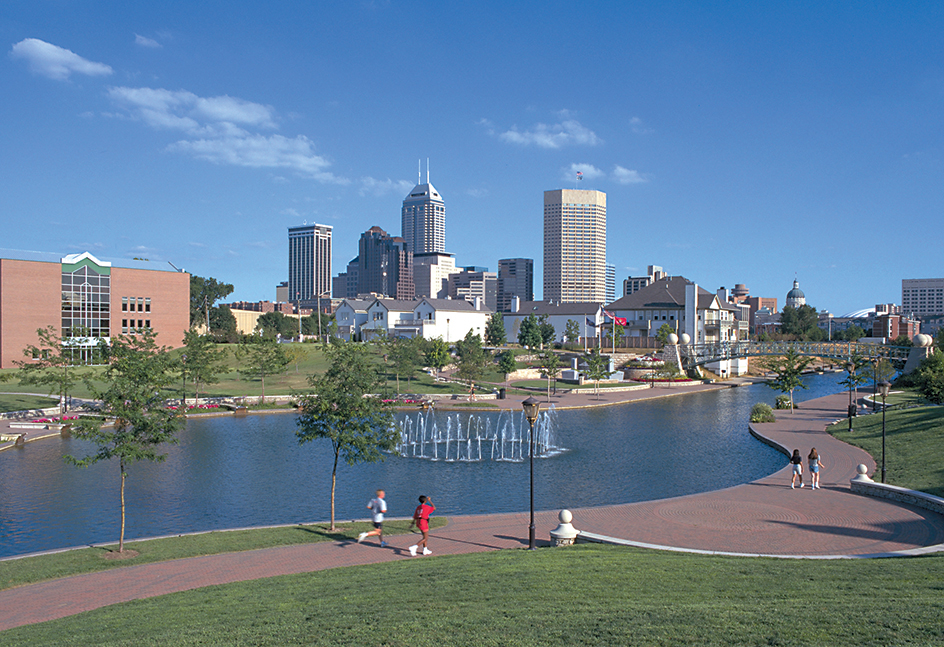
Jeremiah Sullivan, who served as an Indiana Supreme Court judge from 1837 to 1846, made up the city’s name. He combined Indiana with polis, the Greek word for city. The development of industry and transportation, and the city’s role as state capital, have helped Indianapolis grow steadily.
Indianapolis attracts worldwide attention each year in May. The famous Indianapolis 500 automobile race is held during the Memorial Day weekend. About 250,000 spectators jam the Indianapolis Motor Speedway to watch it. For information about the race, including a table of the winners, see Automobile racing.
The city.
The outer boundaries of Indianapolis are the same as those of Marion County. But within the city lie four other communities, each with its own government. They are Beech Grove, Lawrence, Southport, and Speedway. Speedway is the site of the Indianapolis Motor Speedway.
The Indianapolis metropolitan area includes the city, the rest of Marion County, and ten other counties—Boone, Brown, Hamilton, Hancock, Hendricks, Johnson, Madison, Morgan, Shelby, and Tipton.
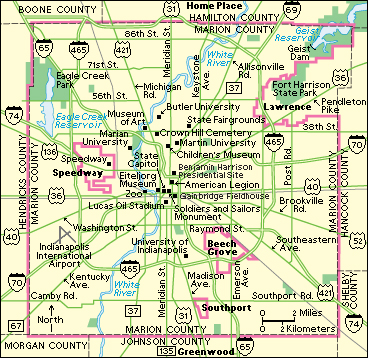
The White River flows through Indianapolis from northeast to southwest. The downtown, or central business, area of Indianapolis lies near the center of the city, east of the river. The heart of this section is called the One-Mile Square. It was designed by Alexander Ralston, an architect who helped plan Washington, D.C. In its center is Monument Circle, with the Soldiers and Sailors Monument, which is 284 1/2 feet (86.7 meters) high. Near Monument Circle are the state capitol and the Indiana War Memorial Plaza, which includes a military museum and the national and state headquarters of the American Legion. Also nearby are Gainbridge Fieldhouse, used for basketball and other events, and the Indiana Convention Center.
Residential areas spread outward in all directions from downtown Indianapolis. The Mile Square also has a number of modern and restored residential buildings.
People.
About half of the people of Indianapolis are of European ancestry, including English, German, Irish, and Italian. African Americans make up about a fourth of the population. Small population groups in the city include people of Asian or Hispanic descent.
Economy.
Many manufacturing firms operate in the Indianapolis metropolitan area. The city’s chief industry is the manufacture of transportation equipment—automotive and aircraft engines, transmissions, truck bodies, and other vehicle parts. Other important industries in Indianapolis include the manufacture of chemical and pharmaceutical products, computer software, electrical and nonelectrical machinery, electronic equipment, and fabricated metals. Food processing and printing and publishing are also important economic activities. 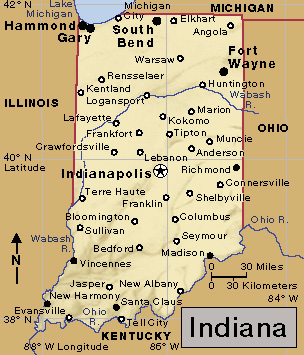
Service industries account for the largest part of the city’s economic activity. This large economic category includes government activities and wholesale and retail trade. Local, state, and federal government agencies employ a large number of the area’s workers. Government projects also create work for other industries. A large technological center, once run by the U.S. Navy, deals with the development, production, and acquisition of electronics used in military aviation.
Indianapolis ranks as one of the Midwest’s chief centers for the distribution of goods. Seven legs of interstate highways and several U.S. routes reach the city. Indianapolis International Airport is about 8 miles (13 kilometers) southwest of the city’s downtown area. Railroad passenger trains connect Indianapolis and other cities. A number of major rail freight lines and trucking firms also serve Indianapolis. The city has one daily newspaper, The Indianapolis Star.
Education.
Indianapolis Public Schools is the largest of the dozens of public school systems in the metropolitan area. A board of seven members heads Indianapolis Public Schools. The members of the board are elected to four-year terms. Many private and parochial schools also serve the city.
Indiana and Purdue universities operate a joint campus in Indianapolis. The university complex includes a school of law and a medical center with schools of dentistry, medicine, and nursing. Other colleges and universities in Indianapolis include Butler University, Christian Theological Seminary, the University of Indianapolis, Marian University, and Martin University.
The Indianapolis Public Library system serves the Indianapolis area. The Indiana State Library and the Indiana Historical Society both house collections of material on Indiana history.
Cultural life.
The Indianapolis Symphony Orchestra performs at the Hilbert Circle Theatre. The Indianapolis Opera performs at Clowes Memorial Hall on the Butler University campus. The Indiana Repertory Theatre, a professional acting company, performs on three stages at the Indiana Theatre.
The Indianapolis Museum of Art contains exhibits of American, European, and Asian art. The Indiana State Museum features natural history displays, and paintings by Indiana artists. The Children’s Museum of Indianapolis has exhibits on such topics as natural history, pioneer life, science and technology, and transportation. The collections of the Eiteljorg Museum of American Indians and Western Art focus on the American Indian and the western United States. The Kurt Vonnegut Museum and Library contains exhibits related to the life and work of the influential writer Kurt Vonnegut, an Indianapolis native.
Recreation.
Indianapolis has a number of public parks. Eagle Creek Park, the largest, has about 5,300 acres (2,100 hectares) of land and water area. The Indianapolis Cultural Trail winds 8 miles (13 kilometers) through the city, connecting a number of sites of cultural interest. The Indianapolis Zoo features hundreds of animal species (kinds) and is well known for its extensive dolphin exhibit. The city is the home of a number of sports teams, including the Indianapolis Colts of the National Football League and the Indiana Pacers of the National Basketball Association. The Indiana State Fair is held at the Indiana State Fairgrounds in late summer.
Other interesting places to visit
include the following:
Conner Prairie Interactive History Park,
about 10 miles (16 kilometers) northeast of downtown Indianapolis, stands on the site where the first white settlers of the Indianapolis area lived. It includes a house built in 1823.
Crown Hill Cemetery,
at 700 W. 38th Street, contains the graves of President Benjamin Harrison, three vice presidents, and the poet James Whitcomb Riley. The notorious criminal John Dillinger is also buried there.
Indianapolis Motor Speedway and Hall of Fame Museum,
in Speedway, about 6 miles (10 kilometers) northwest of the downtown area, is the site of the 500-mile (805-kilometer) automobile race. NASCAR auto races are also held there. The museum features several cars that won the Indianapolis 500.
James Whitcomb Riley Museum Home
stands at 528 Lockerbie Street. Riley, known as the Hoosier Poet, lived there during the last 23 years of his life. Built in 1872, the house contains its original furnishings.
Benjamin Harrison Presidential Site
stands at 1230 N. Delaware Street. Harrison, the 23rd president of the United States, built the house in 1872. He lived there until his death in 1901, except during the years he spent in Washington, D.C.
Scottish Rite Cathedral,
in downtown Indianapolis, is an impressive example of architecture in the Gothic style.
Government.
In January 1970, Indianapolis and Marion County joined together under a unified government, popularly called Unigov. The state law that established Unigov extended the Indianapolis city limits to include all of Marion County except the communities of Beech Grove, Lawrence, Southport, and Speedway. Indianapolis, which formerly covered 82 square miles (212 square kilometers), added about 300 square miles (780 square kilometers) to its area. Unigov combined about 60 city and county government agencies into a small number of departments. 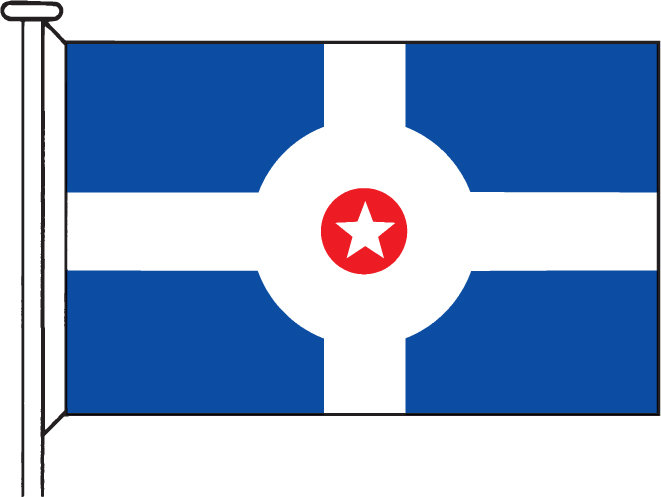
Indianapolis voters elect a mayor and 25 members of the city-county council to four-year terms. Income and property taxes provide most of the city’s revenue.
History.
In early 1820, the George Pogue and John McCormick families became the first white settlers in what is now Indianapolis. The two families and a small group of Delaware Indians were the only people living in the area when it was chosen to be the state capital. In June 1820, a commission selected the area because (1) the site lay near the center of the state and (2) the commissioners thought the nearby White River was navigable. They later discovered that the river was too shallow for large boats.
A lack of good transportation facilities limited the early growth of Indianapolis. The rate of growth increased after the state capital was moved to Indianapolis from Corydon in 1825. More growth took place after the National Road (now U.S. 40) reached Indianapolis from the East in 1830. The community had a population of 1,085 at that time. Indianapolis was incorporated as a town in 1836 and as a city in 1847.
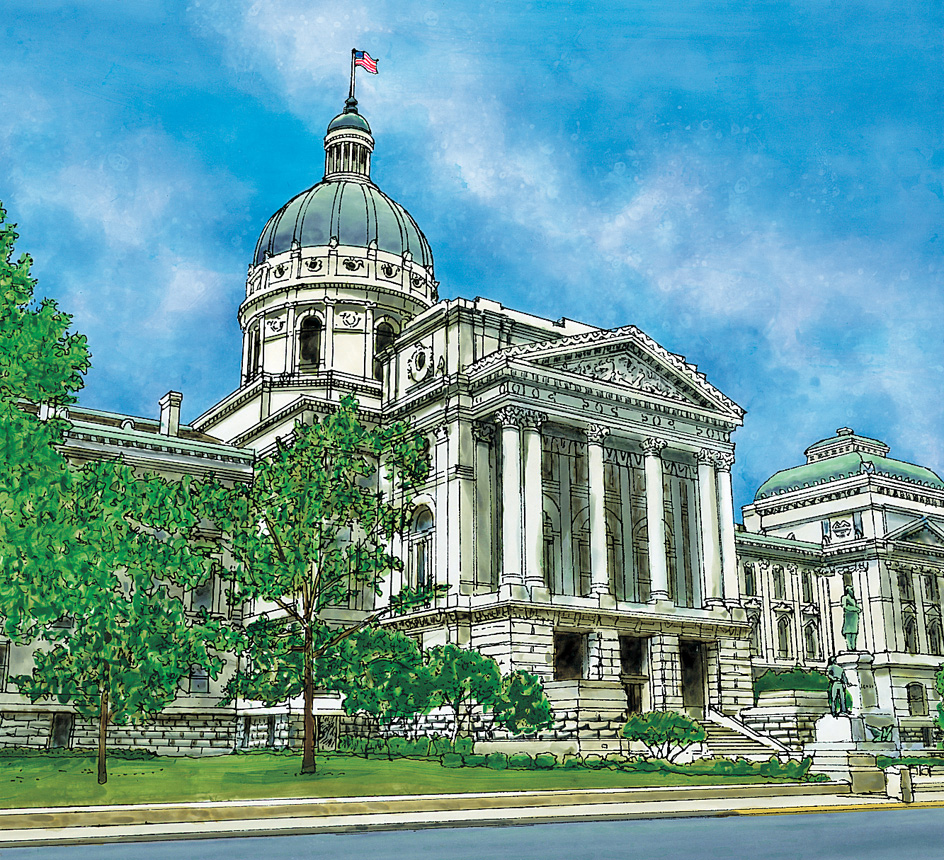
German and Irish immigrants began arriving in 1836 to build a canal between Indianapolis and the nearby town of Broad Ripple. The canal was a financial failure, but in 1847, the first railroad reached Indianapolis. By 1855, eight railroads were serving the city. During the mid-1800’s, Indianapolis became a market for products from nearby farms. It also became a manufacturing center with companies involved in more than 100 industries, including the manufacture of lightning rods, saws, stoves, and wagon wheels. The population of Indianapolis jumped to 8,091 by 1850, to 18,611 by 1860, and to 48,244 by 1870.
The Indianapolis Stockyards opened in 1877. During the 1880’s, the discovery of natural gas in Indiana made cheap fuel available and attracted new industries to Indianapolis. The population reached 169,164 by 1900.
During the early 1900’s, automobile manufacturing became a major industry in Indianapolis. The speedway was built in 1909 to test cars, and the first 500-mile (805-kilometer) race was held there in 1911. By 1920, many car manufacturers had moved to Detroit, and no cars were made in Indianapolis after 1937. But within a few years, the transportation equipment industry expanded to meet the demands of World War II (1939-1945). During the 1940’s, many people moved to Indianapolis to work in industries that made parts for military vehicles. By 1950, the city’s population had increased to 427,173.
Also in 1950, the Western Electric Company began manufacturing telephones in Indianapolis. For many years, more telephones were made there than in any other city in the world. But the company closed its Indianapolis operations in 1986.
Much progress took place in Indianapolis during the 1950’s and 1960’s. Urban renewal projects were carried out; freeways were built; and new cultural, educational, and scientific facilities were established.
In the 1970’s and 1980’s, a number of construction projects were completed in downtown Indianapolis. The Indiana Convention Center opened in 1972. Merchants Plaza, a hotel and office building, opened in 1977. It is now called the Hyatt Regency/PNC Center. The Hoosier Dome (later called the RCA Dome) was completed in 1984 and torn down in 2008 to make room for expansion of the Indiana Convention Center. Union Station, formerly a railroad station, was remodeled into a marketplace in 1986. New apartment complexes and restored old housing in and near downtown attracted many new residents to the area.
In the 1980’s, Indianapolis became a national center for amateur sports. New facilities for swimming and diving, track and field, tennis, gymnastics, bicycle racing, and soccer contests were constructed. Today, the city is the headquarters of many governing organizations of amateur sports, including the National Collegiate Athletic Association (NCAA) and the National Federation of State High School Associations.
In the early 1990’s, several downtown department stores closed. In the mid-1990’s, however, a number of shops returned to the downtown area with the opening of Circle Centre Mall.
In 2008, Lucas Oil Stadium was completed. The stadium, which stands south of the Indiana Convention Center, hosts football and basketball games and other events.
